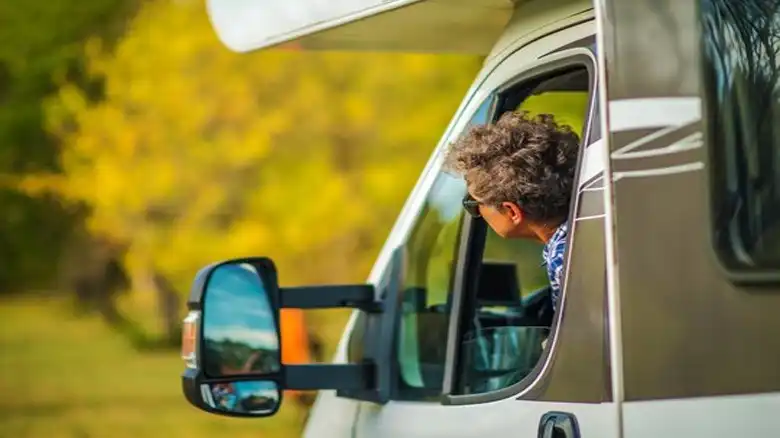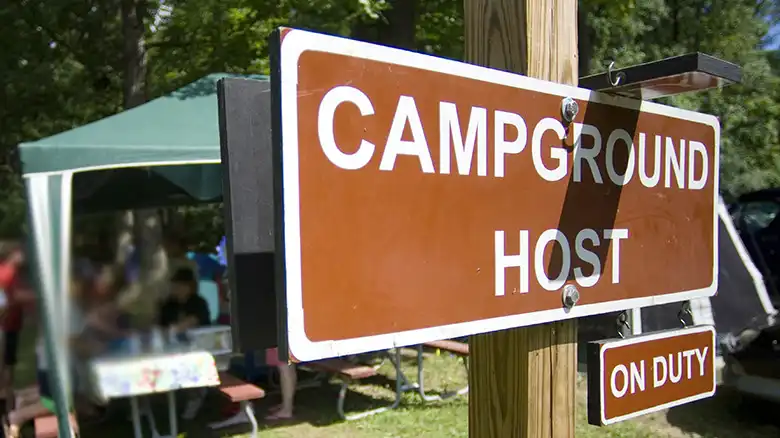Driving an RV is a skill that evolves over time. As a beginner, the sheer size and unique characteristics of an RV may seem intimidating. However, with patience, practice, and proper guidance, you can master the art of RV driving. Whether you’re adjusting mirrors, navigating through challenging terrains, or planning your route, each skill contributes to a more comfortable and rewarding RV journey.
In this guide, we’ll explain the key driving skills, preparation steps, and safety measures that every RV beginner should master for an enjoyable and stress-free adventure. Additionally, we’ll explore the pre-trip preparations, tips for maximizing fuel efficiency, and safety measures that every RV beginner should embrace. So, buckle up as we are here to make RV driving an enjoyable and memorable experience.

Essential RV Driving Skills for Beginners
- Adjusting Mirrors for Maximum Visibility
Proper mirror positioning is crucial for safe RV driving –
- Ensure optimal visibility.
- Eliminate blind spots.
- Angle side mirrors down to view the rear tires and the road’s edge.
- Use convex add-on mirrors for wide peripheral vision.
- Utilize dash cameras if available.
- Understanding Your RV’s Dimensions
Familiarize yourself with your RV’s dimensions to navigate through various environments and obstacles confidently.
- Know your RV’s height, width, length, and tail swing radius to avoid collisions when turning or changing lanes.
This knowledge is essential for navigating narrow roads, avoiding low-hanging obstacles, and maneuvering in tight parking spaces.
- Navigating Turns and Managing Tail Swing
When turning, take wider turns to prevent jackknifing, where the RV trailer swings out abruptly. Be mindful of your tail swing, the portion of your RV that extends behind the rear axle.
- Navigate turns with confidence.
- Understand and manage tail swing.
- Drive slowly in empty lots to get a feel for wide pivots and trailer tail whip.
- Backing Up and Reversing with Confidence
Develop the crucial skill of backing up and maneuvering in reverse to navigate tight spots with ease.
- Practice backing up in open spaces.
- Use a spotter when reversing until you gain experience gauging distances.
- Add backup cameras to assist visibility.
Backing up and maneuvering in reverse requires patience and practice. Utilize your mirrors and consider adding a rearview camera system for better visibility.
- Maintaining Proper Speed and Braking Distance
Learn to maintain a proper speed and braking distance, ensuring a smooth and controlled driving experience.
- Drive at a safe and controlled speed.
- Understand braking distances.
- Brake early and gently due to slower response times and extra momentum.
- Leave 50% more spacing between vehicles to compensate.
- Driving on Hills, Mountains, and Uneven Terrain
Gain insights into driving on diverse terrains, and adjusting your approach to hills, mountains, and uneven surfaces.
- Adjust speed and gear appropriately.
- Understand the impact of braking.
- Drive slowly over bumpy roads, railroad tracks, or drainage ditches.
- Position wheels to straddle or approach diagonally.
- Finding RV-Friendly Routes and Parking
Discover the tools and strategies for finding routes and parking spaces suitable for your RV.
- Utilize RV-specific GPS apps.
- Plan for RV-friendly parking.
- Use apps to identify low-clearance bridges, tight turns, and steep grades when trip planning.
Preparing for Your First RV Trip
Step 1: Take an RV Driving Course or Practice in Empty Parking Lots
- Consider enrolling in an RV driving course or practicing in empty lots to build confidence and skills.
- Invest in professional guidance.
- Practice in open spaces.
Step 2: Walk Around the RV and Check the Exterior Before Driving
- Inspect tires, lights, and overall condition
- Ensure everything is secure
- Develop a pre-departure routine of walking around your RV, checking for any issues, and ensuring everything is secure.
Step 3: Secure Interior Items and Prepare Passengers
- Secure loose items inside the RV
- Brief passengers on safety guidelines
- Ensure a safe and comfortable interior by securing loose items and briefing passengers on safety guidelines.
Step 4: Add an Experienced Passenger or Second Driver If Possible
- Share driving responsibilities
- Leverage experience for guidance
- Consider having an experienced passenger or a second driver to share responsibilities and provide guidance.
Building skill and confidence through training prevents mishaps down the road.
Maximizing Fuel Efficiency in Your RV
- Plan Your Route Efficiently: Plan your route carefully to avoid unnecessary detours and minimize highway congestion.
- Maintain Proper Speed: Avoid excessive speeding, as it can significantly impact fuel economy.
- Reduce Unnecessary Weight: Remove unnecessary items from your RV to reduce overall weight, improving fuel efficiency.
- Regular Maintenance: Ensure your RV is well-maintained, including regular oil changes and tire inspections, to optimize fuel consumption.
Best Apps, Resources, and Support for New RV Drivers
- Useful Apps: Utilize RV-specific apps like RV Life and RV Parky for route planning, campground reviews, and fuel station locations.
- Forums and Groups: Join online forums and groups dedicated to RVing to connect with experienced RVers for advice and support.
- Practice Sessions at Dealerships: Many RV dealerships offer practice sessions to help beginners familiarize themselves with their vehicles.
- RV-Friendly GPS System: Invest in an RV-friendly GPS system that accounts for vehicle dimensions and provides specific RV-friendly routes.
- Roadside Assistance Coverage: Obtain roadside assistance coverage to ensure you have help in case of breakdowns or emergencies.
Top Safety Tips for a Smooth RV Journey
Here are some safety tips to follow:
- Remain focused on driving – avoid phones and passengers distracting you.
- Maintain awareness all around the vehicle at all times
- Get plenty of rest before long trips.
- Plan for breaks during long drives.
- Check weather forecasts using the Weather Channel app and plan accordingly.
- Obey all traffic laws allowing for slower acceleration and stopping
- Watch signs for clearance limits and speed reductions
Internalizing safe habits keeps everyone secure inside and outside your RV.
Conclusion
Driving an RV requires adjusting thinking to responsibly operate a living space on wheels. Cautiously embrace the challenge through formal training, constant practice, and utilizing assistive technology. Do not rush the process or overestimate your abilities early on. Lay a foundation of competence before ambitiously venturing far. Soon, navigation skills catch up with imagination. Confidently captain adventures that last lifetimes.


